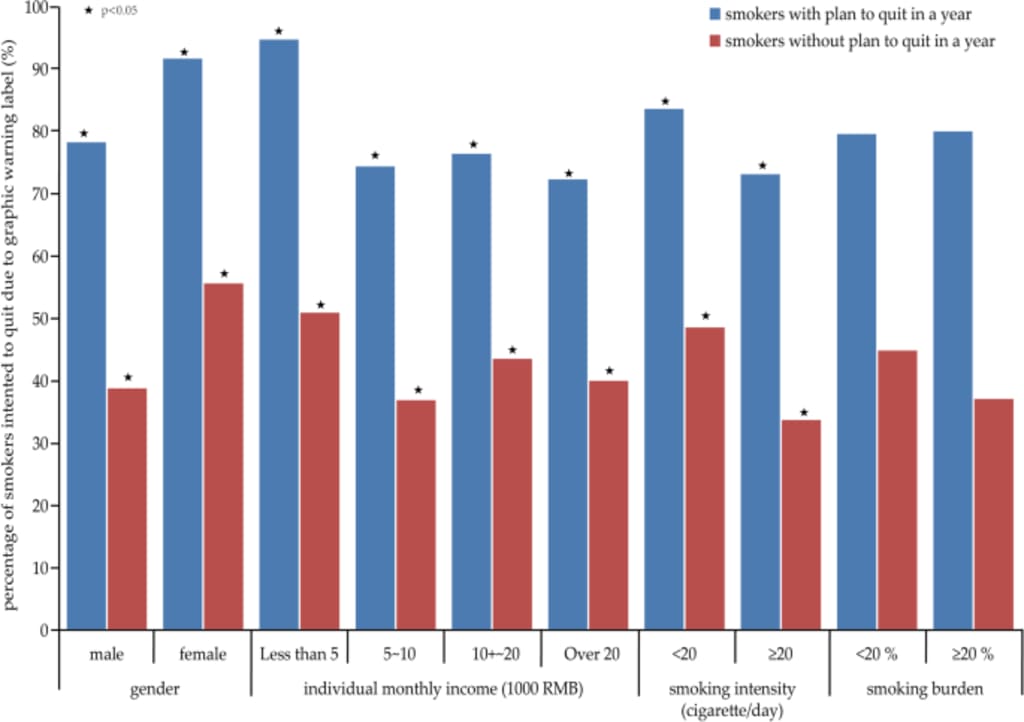Effect of Warning Labels on Graphic Cigarette Packaging on US Smokers
Graphic Cigarette Packaging

Effects of graphic warning labels on cigarette packaging were largely consistent with previous controlled studies. Qualitative findings suggest that graphic warning labels may promote defensive responses and self-referential processing. This article describes the effects of graphic warning labels on US smokers.
Effect of warning labels on graphic cigarette packaging on smoking cessation intention
Graphic warning labels on cigarette packages have been shown to increase smokers' awareness of the negative health consequences of smoking. They also seem to encourage smokers to quit smoking, with a significant impact on smokers aged 18 and younger. These findings highlight the value of scientifically proven methods to inform the public.
Currently, graphic warning labels are required on cigarette packages in over 100 countries. They carry important public health messages and have been the focus of significant pressure from Big Tobacco. Despite this, Australia and Uruguay have successfully defended their law against Big Tobacco and have implemented new warnings and images on cigarette packages.
However, these graphic warning labels may not fully affect the intention of current smokers to quit smoking. Similarly, smokers with a heavier nicotine dependence may not be fully influenced by these warnings. However, current smokers with lower tobacco burden and lower intensity of smoking are more likely to consider quitting. Message impact theories explain why GWLs can lead smokers to quit smoking, but there is also evidence that graphic warning labels can trigger defensive responses in smokers.
The effects of warning labels on graphic cigarette packaging on US smokers' intention to quit smoking have been well studied. Researchers have found that graphic safety labels are associated with more negative emotional responses, greater awareness of health risks associated with tobacco consumption, and higher intention to quit smoking. Graphic safety labels also appear to be more persuasive than text-only safety labels, as evidenced by a number of studies.
While the effects of graphic cigarette warning labels on smoking cessation intention in US smokers are well known, their effectiveness is uncertain. More research needs to be conducted to test the effectiveness of this strategy. However, it is clear that graphic warning labels do increase smoking cessation intentions for both male and female smokers.
The results of this research suggest that the effects of graphic warning labels on smoking cessation intention in US smokers may be enhanced by role model-based efficacy messages. These messages could help to improve the effectiveness of these labels by improving smokers' self-efficacy beliefs.
In a randomized clinical trial, a group of US smokers was randomly assigned to a group that had a GWL and another group who didn't. Participants were asked to answer questionnaires about their smoking history, age, and time to their first cigarette. The questionnaires also assessed their intention to quit smoking. Participants were asked to rate their intentions to quit smoking, ranging from low to high.
In addition, smokers were asked about their beliefs about smoking. Among the health outcomes of smoking, they assessed their beliefs about impotence, oral cancer, and stroke. Smoking cessation intention was related to education and health knowledge. The researchers then used logistic regression models to examine the association between the warning labels and quit intention.
Influence of warning labels on smoking initiation
The effectiveness of pictorial warnings on smoking initiation and cessation is not yet fully understood, but future research should examine whether they are as effective as text warnings on smoking behavior. Such studies should adopt more explicit hypotheses derived from behavioral theory and use validated measures of smoking behavior.
The researchers conducted a survey with 374 participants. Of these, 195 participants were females, while 40 percent were Hispanic. The majority had a high school education and had been smoking for at least one year. The participants smoked less than one pack per day on average. One-third of the participants also smoked other tobacco products within the past month.
https://thecigaretteboxes.com/
A recent study in the Journal of Public Health Psychology found that graphic warning labels can reduce smoking initiation in both men and women. These warnings can influence the likelihood of smokers displaying their packs in public. But it is unclear whether such warnings affect pack-hiding behavior. In this study, researchers evaluated the effectiveness of a warning label on the willingness of smokers to show their packs.
The authors of the study found that a picture-based warning was more effective than text-based warnings. This was true for five of the six constructs assessed: cognitive elaboration, perceived credibility, aversiveness, and smoking cravings. Furthermore, a pictorial warning significantly reduced the likelihood of smoking.
The authors of the study argued that graphic warning labels on cigarettes could have prevented thousands of smoking-related deaths. However, the authors noted that the 'multiple factors' that influence the reaction of smokers to a warning label are difficult to assess. Further research is needed to examine the effects of warning labels on the habit among US smokers.
The authors acknowledge the assistance of those who provided additional data and made this study possible. A graphic warning on tobacco products is not yet widely implemented in the US. The study is limited in its scope, and it is important to note that the onset of smoking in childhood has been related to an elevated risk of all-cause mortality.
The study found that a graphic health warning on cigarette packs significantly reduced smoking initiation among US smokers. It also found that cigarette packs with GWLs on the front of the pack were significantly more effective than those with text-only warnings. The findings indicate that the graphic health warnings on cigarette packs are beneficial to a number of vulnerable populations. For example, persons living with HIV or other infectious diseases bear a disproportionate burden due to smoking. Further, smoking negatively affects the effectiveness of ARV medications.
Influence of warning labels on smoking cessation intention
Studies show that the stronger warnings on cigarette packs increase the intention of smokers to quit smoking by as much as 2.4 fold. However, the effect of graphic warnings is not universal. Some studies suggest that less graphic warnings are just as effective in raising quit intentions. In this article, we explore the impact of cigarette warnings on smoking cessation intentions among US smokers.
Emotional safety labels have been shown to improve the effectiveness of warnings about smoking cessation. In a study of 1,932 adult smokers, high-emotion safety labels were associated with higher recall and greater perceptions of tobacco-related health risks. Moreover, smokers who recalled high-emotion safety labels were more likely to quit smoking than those who had seen only moderate-emotional ones. High-emotion safety labels evoked negative emotional responses in smokers, which facilitated their motivation to quit smoking and reduced tobacco consumption.
Graphic safety labels produced greater negative emotional responses and increased quit intentions than text-only safety labels. Compared to text-only safety labels, larger graphic labels caused greater negative emotional responses and higher perceptions of tobacco-related health risks. However, no significant differences were observed among youths.
https://thecigaretteboxes.com/
In a previous study, we found that adolescents' intention to quit was significantly affected by the presence of warning labels on cigarettes. The results showed that adolescents' intention to quit smoking was greater when warning labels were paired with physicians' advice about quitting. In addition, youths who were not smokers at the time of the study reported higher quit intentions when exposed to tobacco control advertisements. However, we need more research to determine if graphic warning labels have any influence on quit intentions.
The study also looked at the impact of warning labels on the choice of cigarette packs. The study included a comparison between cigarette packs with GWLs and those with text-only warning labels. In general, those with GWLs chose cheaper packs of cigarettes, while those with text-only warning labels chose the more expensive ones.
Despite the potential influence of warning labels, smoking continues to be a major health concern in the United States. Moreover, the Surgeon General's warning did not convey specific health information to the youth. In addition, youth cannot remember text-only warnings. Recent studies have shown that graphic warnings attract attention and trigger emotional reactions. Furthermore, youth spend more time looking at graphic warnings, and gaze duration predicts recall.
About the Creator
Matthew Kelley
I’m Matthew. After gaining worthy experience in marketing, I have been working as a marketing expert. Located in Jacksonville, United States. I’m also interested in manufacturing and packaging. Marketing manager at CBD packaging.






Comments
There are no comments for this story
Be the first to respond and start the conversation.